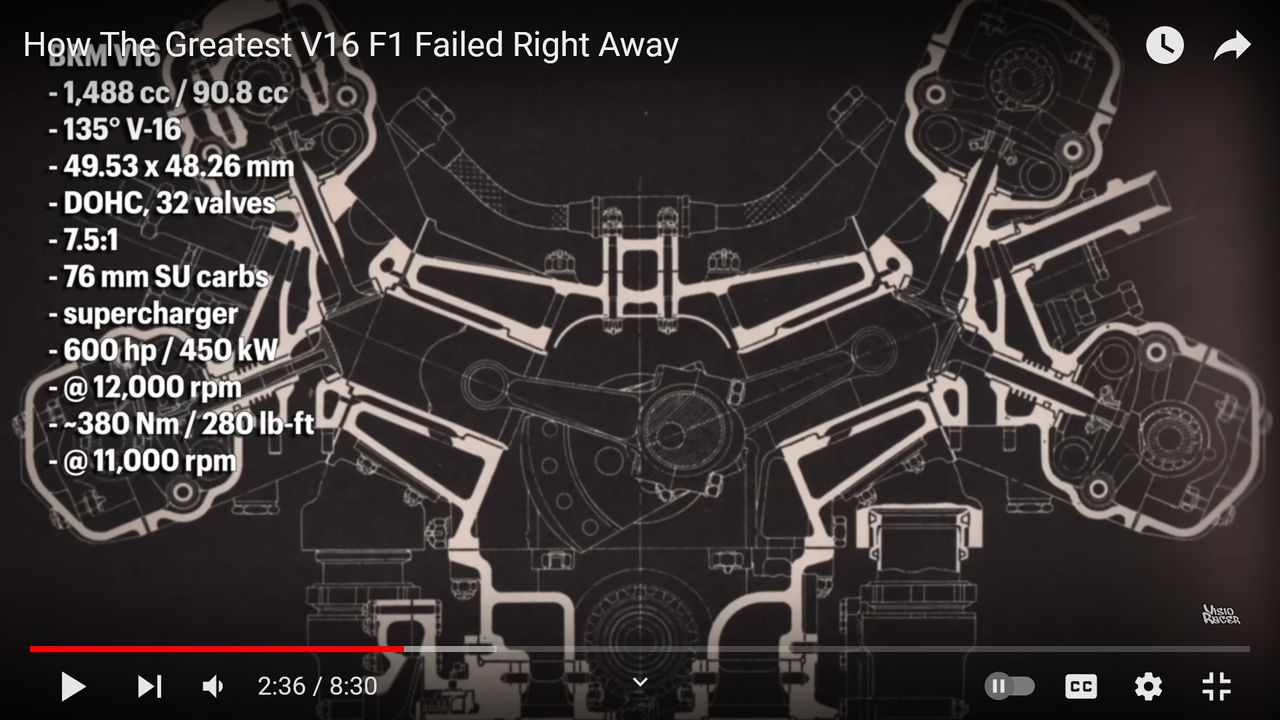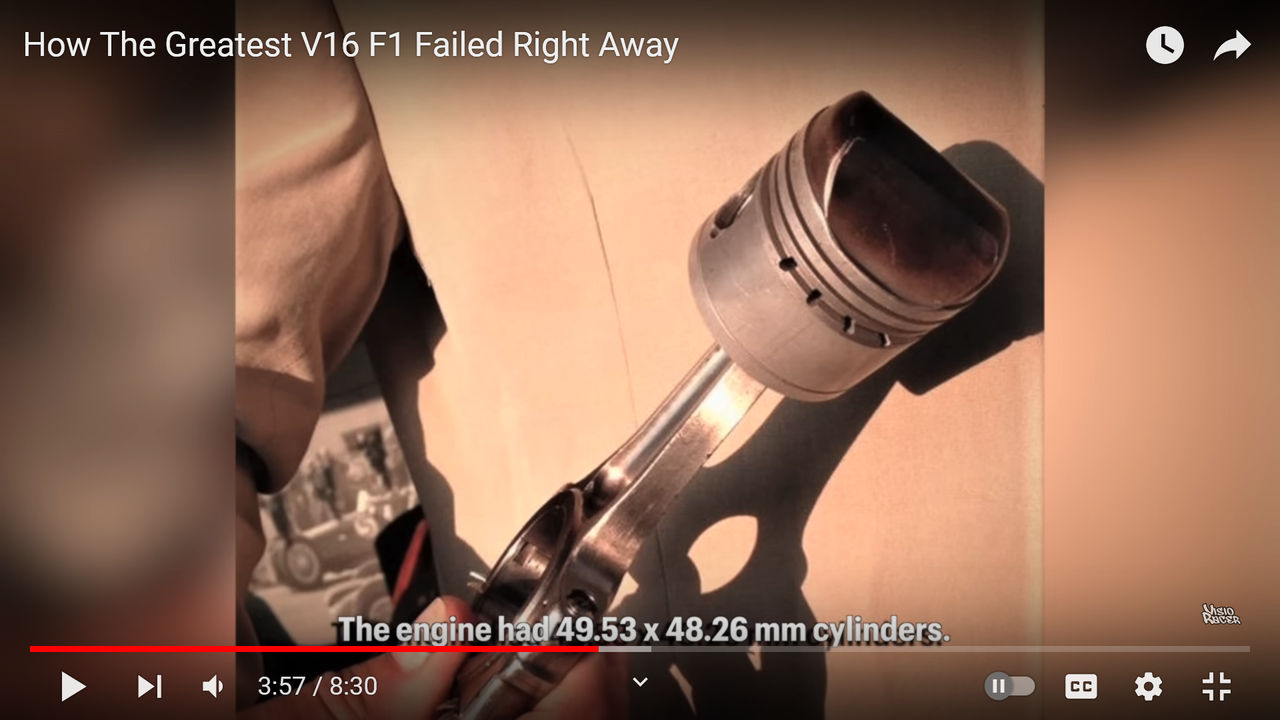82 PSI boost!
If anyone has information on 1. Firing order 2. Valve timing 3. Fuel, it would be appreciated.




Thanks TommyTommy Cookers wrote: ↑08 Sep 2022, 10:44BRM are stated currently (2021) to be using 80% methanol 10% acetone 10% petrol
they might better have stated 80% methanol with acetone and petrol the minor ingredients
(more or less what the 1951 WDC-dominant Tipo 159 F1 Alfa Romeo used)
BRM's bizarre behaviour in early 1952 caused the summary replacement of F1 by F2 for the 1952 WDC and the 1953 WDC
also bizarre behaviour - this site stating eg that the 1952 WDC Dutch GP etc was F1
That is making some sensesaviour stivala wrote: ↑08 Sep 2022, 21:43Inlet valve 31.8mm. exhaust valve 37.8mm. valve lift 5.1mm. valve open duration 300 degrees.
Firing each cylinder through a small aperture was a 14mm Lodge spark plug. Sparks generated by battery powered coil ignition system. a 4-cylinder distributor was driven from the front of each cam and supplied with its own coil. Each distributor had 3-sets of points, one made contact, one broke it and one (manually selected) gave a retard timing for starting the engine.
the Ludvigsen book (priceless and easily Google-read) gives ....johnny comelately wrote: ↑09 Sep 2022, 03:00That is making some sensesaviour stivala wrote: ↑08 Sep 2022, 21:43Inlet valve 31.8mm. exhaust valve 37.8mm. valve lift 5.1mm. valve open duration 300 degrees.
Being a 2 valve and a 14cc chamber with that crown.
the 5.1 lift allows for piston to valve clearance.
I wondered about the 300/300 for a supercharged engine but considering the above limitations it was necessary to get adequate cylinder fill .
The only way to produce the power with all those restrictions is the 82 psi boost.
They mention 12K rpm with hairpin springs so again the 5.1 makes sense, all the same its amazing revs.
4:1 belt drive , or was there exhaust on one stage?? shows the need for the 6" compressor
was there an intercooler??
A question for Tommy, when did they invent the candy for reducing the water absorption in methanol?
Tommy Cookers wrote: ↑09 Sep 2022, 13:07the Ludvigsen book (priceless and easily Google-read) gives ....johnny comelately wrote: ↑09 Sep 2022, 03:00That is making some sensesaviour stivala wrote: ↑08 Sep 2022, 21:43Inlet valve 31.8mm. exhaust valve 37.8mm. valve lift 5.1mm. valve open duration 300 degrees.
Being a 2 valve and a 14cc chamber with that crown.
the 5.1 lift allows for piston to valve clearance.
I wondered about the 300/300 for a supercharged engine but considering the above limitations it was necessary to get adequate cylinder fill .
The only way to produce the power with all those restrictions is the 82 psi boost.
They mention 12K rpm with hairpin springs so again the 5.1 makes sense, all the same its amazing revs.
4:1 belt drive , or was there exhaust on one stage?? shows the need for the 6" compressor
was there an intercooler??
A question for Tommy, when did they invent the candy for reducing the water absorption in methanol?
inlet 277 deg and 1/4" (6.35mm) lift - exhaust 259 deg THANKS FOR THOSE DURATIONS AND THE BOOK TIP, BUT THE TIMINGS ARE MORE RELEVANT IF YOU COME ACCROSS THOSE. 6.35 LIFT WOULD BE VERY DIFFICULT WITH 14CC CHAMBER, THE 5.1 SEEMS MORE FEASIBLE, PARTICULARLY BEING GOVERNED BY THE CLIP.
there was no intercooler as eg the 70% methanol option was chosen by BRM . WITH A DRIBBLE INTO THE SUPERCHARGER INLET
restrictions - what restrictions ? .....2 VALVES, LOW LIFT
the 2 stage gear driven supercharger was efficient at eg 82 psi or whatever
the CR was chosen according to the MAP and breathing - if breathing magically improved the engine would detonate. THERE IS NO MAGIC, MANY THINGS EFFECT THE TRUE PRE IGNITION PRESURE, VALVE TIMING FOR ONE
(lower CR pistons were available)
isn't supercharger work (at a given pressure) less with 'restricted' engine breathing than with 'unrestricted' ? MOOT POINT, THE POINT IS THAT IT IS RESTRICTED.
like the Merlin ... nobody died .....
ok RR moaned about breathing - but they also told Rudd he could get 800 hp or 1000 hp
the 1968 SAGP V16 demo by Hill was said to have the final mod state and 780 hp
iirc 'Speed & how to obtain it' said that acetone was in blends of methanol/petrol to suppress water separation
I assume that methanol absorbs atmospheric water vapour as does ethanol. YES IT DOES AND DRAMATICALLY HENCE THE QUESTION ABOUT WHEN THE CANDY WAS USED/INVENTED
maybe this is only important at low alcohol % not high alcohol % (eg as E10 is probably less affected than E5)
ok acetone is similar to recent road fuel ingredients MTBE
ok it's not a bad fuel if 70% of your fuel is methanol. I WOULD HAVE GUESSED AT 90%
BRM could have used the V16 as a 1954-60 F1 750cc boosted V8, 1961-5 1500cc NA V16 and 1966-1993? boosted V16
the V16 didn't had quite small crankshaft bearings as the power loads (mep) were quite small
porting was adaptable to 'tuned length' induction and exhaust systems (yes the valve lift would be an issue for NA)
anyway 1950s engines populated 1966/7 F1 - and the V16 couldn't have been more trouble than the H16 was
(remember Coventry Climax made a 1.5 litre NA flat-16 - 'Autocar' said they could supercharge it for 1966)
afaik BRM are currently making a batch of the V16 cars. YES, FROM WHAT I HAVE SEEN THEY HAVE REMANUFACTURED ALL NEW ENGINES FROM THE ORIGINAL DRAWINGS
WAS IT A HIRTH COUPLING FOR THE CRANKSHAFTS?
johnny comelately wrote: ↑10 Sep 2022, 00:32Tommy Cookers wrote: ↑09 Sep 2022, 13:07iirc 'Speed & how to obtain it' said that acetone was in blends of methanol/petrol to suppress water separation
HENCE THE QUESTION ABOUT WHEN THE CANDY WAS USED/INVENTED
reply .... 1930s-1950s
WAS IT A HIRTH COUPLING FOR THE CRANKSHAFTS?
reply ...yes, Hirth was differential thread pitches - the difference of course more like 1TP/metre than 1TP/inch
isn't supercharger work (at a given pressure) less with 'restricted' engine breathing than with 'unrestricted' ?
MOOT POINT, THE POINT IS THAT IT IS RESTRICTED.
reply ...disagree, no benefit improving valves just to allow lower boost (as supercharger efficiency doesn't increase)
eg current F1 is 'restricted' by 'Miller cycle' - but the supercharger work is far less than without this 'restriction'
both the V16 and current F1 would 'blow up' without their 'restrictions' (unless CR was reduced of course)
ok when (with a good supercharger) inlet valve gas velocity goes supersonic that is a restriction
Pretty sure the inlet valve was larger than the exhaust - like most engines.